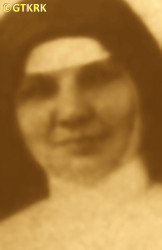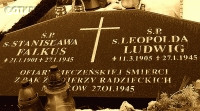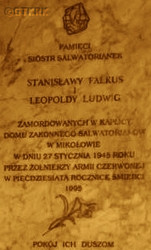Roman Catholic
St Sigismund parish
05-507 Słomczyn
85 Wiślana Str.
Konstancin deanery
Warsaw archdiocese, Poland
full list:
displayClick to display full list

searchClick to search full list by categories
wyświetlKliknij by wyświetlić pełną listę po polsku

szukajKliknij by przeszukać listę wg kategorii po polsku

Martyrology of the clergy — Poland
XX century (1914 – 1989)
personal data
religious status
Servant of God
surname
FALKUS
surname
versions/aliases
FALKUŚ
forename(s)
Agnes (pl. Agnieszka)
religious forename(s)
Stanislava (pl. Stanisława)
function
nun
creed
Latin (Roman Catholic) Church RCmore on
en.wikipedia.org
[access: 2014.09.21]
congregation
Sisters of the Divine Savior SDSmore on
en.wikipedia.org
[access: 2021.07.04]
(i.e. Salvatorian Sisters)
date and place
of death
27.01.1945

Mikołówtoday: Mikołów urban gm., Mikołów pov., Silesia voiv., Poland
more on
en.wikipedia.org
[access: 2021.12.18]
details of death
After German and Russian invasion of Poland in 09.1939 and start of the World War II, after Salvatorian Fathers' were evicted from their monastery in Mikołów, helped and served in 4 Rybnicka Str. where friars moved in — together with Sr Leopolde Ludwig, among others.
During, the final Russian winter offensive of 1945 of the World War II — started by German and Russian invasion of Poland in 09.1939 — Russians entered their house, persuaded by Ukrainians staying in Mikołów who accused friars and nuns of collaboration with Germans.
Russians started with robbery: suitcases, watches.
Next demanded vodka.
Friars and nuns attempted to hide in the house chapel but friars were forcibly thrown out of it, leaving Sr Leopolde and Sr Stanislava alone.
Both were brutally raped and murdered by Russians.
Sr Stanislava was found by the altar, bloodied — stabbed with bayonets, beaten and finally shot.
By the head lay set of her teeth knocked out by the murderers.
cause of death
mass murder
perpetrators
Russians
sites and events
Mass rapes in 1945Click to display the description, «Genocidium Atrox»Click to display the description, Ribbentrop‐MolotovClick to display the description, Pius XI's encyclicalsClick to display the description
date and place
of birth
21.01.1901

Stara Kuźniatoday: part of Halemba district in Ruda Śląska, Ruda Śląska city pov., Silesia voiv., Poland
more on
en.wikipedia.org
[access: 2022.01.28]
parents
FALKUS Francis
🞲 ?, ? — 🕆 ?, ?

KOŁODZIEJ Mary
🞲 ?, ? — 🕆 ?, ?
religious vows
10.1930 (temporary)
1936 (permanent)
positions held
1939 – 1945
nun — Mikołówtoday: Mikołów urban gm., Mikołów pov., Silesia voiv., Poland
more on
en.wikipedia.org
[access: 2021.12.18] ⋄ Congregation's house, Salvatorian Sisters SDS — deputy provincial superior
nun — Krakówtoday: Kraków city pov., Lesser Poland voiv., Poland
more on
en.wikipedia.org
[access: 2021.06.07] ⋄ Congregation's house, Salvatorian Sisters SDS
c. 1936
nun — Goczałkowice‐Zdrójtoday: Goczałkowice‐Zdrój gm., Pszczyna pov., Silesia voiv., Poland
more on
en.wikipedia.org
[access: 2022.04.17] ⋄ Congregation's house, Salvatorian Sisters SDS
nun — Trzebiniatoday: Trzebinia gm., Chrzanów pov., Lesser Poland voiv., Poland
more on
en.wikipedia.org
[access: 2021.06.07] ⋄ Congregation's house, Salvatorian Sisters SDS
novitiate — Berlintoday: Berlin state, Germany
more on
en.wikipedia.org
[access: 2020.07.31] ⋄ Salvatorian Sisters SDS
28.08.1928
accession — Berlintoday: Berlin state, Germany
more on
en.wikipedia.org
[access: 2020.07.31] ⋄ Salvatorian Sisters SDS
till 1928
employee — Krakówtoday: Kraków city pov., Lesser Poland voiv., Poland
more on
en.wikipedia.org
[access: 2021.06.07] ⋄ Society's House, Salvatorians SDS — kitchen help
employee — Wirektoday: district of Ruda Śląska, Ruda Śląska city pov., Silesia voiv., Poland
more on
en.wikipedia.org
[access: 2022.01.28] ⋄ Germ. Hugohütte (Eng. „Hugo” zinc smelter)
employee — Piaśnikitoday: district in Świętochłowice, Świętochłowice city pov., Silesia voiv., Poland
more on
en.wikipedia.org
[access: 2021.04.02] ⋄ hospital
from c. 1918
housemaid — Lipinytoday: district in Świętochłowice, Świętochłowice city pov., Silesia voiv., Poland
more on
en.wikipedia.org
[access: 2022.05.23]
others related
in death
LUDWIGClick to display biography Gertrude (Sr Leona)
sites and events
descriptions
Mass rapes in 1945: During capture in 1944‐1945 of pre‐war German territories and territories incorporated into Germany in 1939 after German invasion of Poland Russian soldiers committed mass, often multiple, rapes on mainly German, but also Polish, women. Up to 2 mln women might have been violated, from 8 to 80 or more years old. Many were murdered as a consequence. Rapes were prob. tolerated if not encouraged by Russian military and civilian NKVD commanders. (more on: en.wikipedia.orgClick to attempt to display webpage
[access: 2015.03.01])
«Genocidium Atrox»: In 1939‐1947, especially in 1943‐1944, independent Ukrainian units, mainly belonging to genocidal Ukrainian organizations OUN (political arm) and UPA (military arm), supported by local Ukrainian population, murdered — often in extremely brutal way — in Volyn and surrounding regions of pre‐war Poland, from 130,000 to 180,000 Poles, all civilians: men, women, children, old and young. Polish‐Ukrainian conflict that openly emerged during and after World War I (in particular resulting in Polish‐Ukrainian war of 1918‐1919), that survived and even deepened later when western Ukraine became a part Poland, exploded again after the outbreak of the World War II in 09.1939. During Russian occupation of 1939‐1941, when hundreds of thousands of Poles were deported into central Russia, when tens of thousands were murdered (during so‐called Katyń massacres, among others), this open conflict had a limited character, helped by the fact that at that time Ukrainians, Ukrainian nationalists in particular, were also persecuted by the Russians. The worst came after German‐Russian war started on 22.06.1941 and German occupation resulted. Initially Ukrainians supported Germans (Ukrainian police was initiated, Ukrainians co—participated in extermination of the Jews and were joining army units fighting alongside Germans). Later when German ambivalent position towards Ukraine became apparent Ukrainians started acting independently. And in 1943 one of the units of aforementioned Ukrainian OUN/UPA organization, in Volyn, started and perpetrated a genocide of Polish population of this region. In mere few weeks OUN/UPA murdered, with Germans passively watching on the sidelines, more than 40,000 Poles. This strategy was consequently approved and adopted by all OUN/UPA organisations and similar genocides took place in Eastern Lesser Poland (part of Ukraine) where more than 20,000 Poles were slaughtered, meeting however with growing resistance from Polish population. Further west, in Chełm, Rzeszów, etc. regions this genocide turned into an extremely bloody conflict. In general genocide, perpetrated by Ukrainian nationalists, partly collaborating with German occupants, on vulnerable Polish population took part in hundreds of villages and small towns, where virtually all Polish inhabitants were wiped out. More than 200 priests, religious and nuns perished in this holocaust — known as «Genocidium Atrox» (Eng. „savage genocide”) The nature and purpose of genocide is perhaps best reflected in the song sung by the murderers: „We will slaughter the Poles, we will cut down the Jews, we must conquer the great Ukraine” (ukr. „Поляків виріжем, Євреїв видусим, велику Україну здобути мусим”). This holocaust and conflict ended up in total elimination of Polish population and Polish culture from Ukraine, in enforced deportations in 1944‐1945 of remaining Poles from Ukraine and some Ukrainians into Ukraine proper, and finally in deportation of Ukrainians from East‐South to the Western parts of Polish republic prl by Commie‐Nazi Russian controlled Polish security forces („Vistula Action”). (more on: www.swzygmunt.knc.plClick to attempt to display webpage
[access: 2021.06.20])
Ribbentrop‐Molotov: Genocidal Russian‐German alliance pact between Russian leader Joseph Stalin and German leader Adolf Hitler signed on 23.08.1939 in Moscow by respective foreign ministers, Mr. Vyacheslav Molotov for Russia and Joachim von Ribbentrop for Germany. The pact sanctioned and was the direct cause of joint Russian and German invasion of Poland and the outbreak of the World War II in 09.1939. In a political sense, the pact was an attempt to restore the status quo ante before 1914, with one exception, namely the „commercial” exchange of the so‐called „Kingdom of Poland”, which in 1914 was part of the Russian Empire, fore Eastern Galicia (today's western Ukraine), in 1914 belonging to the Austro‐Hungarian Empire. Galicia, including Lviv, was to be taken over by the Russians, the „Kingdom of Poland” — under the name of the General Governorate — Germany. The resultant „war was one of the greatest calamities and dramas of humanity in history, for two atheistic and anti‐Christian ideologies — national and international socialism — rejected God and His fifth Decalogue commandment: Thou shall not kill!” (Abp Stanislav Gądecki, 01.09.2019). The decisions taken — backed up by the betrayal of the formal allies of Poland, France and Germany, which on 12.09.1939, at a joint conference in Abbeville, decided not to provide aid to attacked Poland and not to take military action against Germany (a clear breach of treaty obligations with Poland) — were on 28.09.1939 slightly altered and made more precise when a treaty on „German‐Russian boundaries and friendship” was agreed by the same murderous signatories. One of its findings was establishment of spheres of influence in Central and Eastern Europe and in consequence IV partition of Poland. In one of its secret annexes agreed, that: „the Signatories will not tolerate on its respective territories any Polish propaganda that affects the territory of the other Side. On their respective territories they will suppress all such propaganda and inform each other of the measures taken to accomplish it”. The agreements resulted in a series of meeting between two genocidal organization representing both sides — German Gestapo and Russian NKVD when coordination of efforts to exterminate Polish intelligentsia and Polish leading classes (in Germany called «Intelligenzaktion», in Russia took the form of Katyń massacres) where discussed. Resulted in deaths of hundreds of thousands of Polish intelligentsia, including thousands of priests presented here, and tens of millions of ordinary people,. The results of this Russian‐German pact lasted till 1989 and are still in evidence even today. (more on: en.wikipedia.orgClick to attempt to display webpage
[access: 2015.09.30])
Pius XI's encyclicals: Facing the creation of two totalitarian systems in Europe, which seemed to compete with each other, though there were more similarities than contradictions between them, Pope Pius XI issued in 03.1937 (within 5 days) two encyclicals. In the „Mit brennender Sorge” (Eng. „With Burning Concern”) published on 14.03.1938, condemned the national socialism prevailing in Germany. The Pope wrote: „Whoever, following the old Germanic‐pre‐Christian beliefs, puts various impersonal fate in the place of a personal God, denies the wisdom of God and Providence […], whoever exalts earthly values: race or nation, or state, or state system, representatives of state power or other fundamental values of human society, […] and makes them the highest standard of all values, including religious ones, and idolizes them, this one […] is far from true faith in God and from a worldview corresponding to such faith”. On 19.03.1937, published „Divini Redemptoris” (Eng. „Divine Redeemer”), in which criticized Russian communism, dialectical materialism and the class struggle theory. The Pope wrote: „Communism deprives man of freedom, and therefore the spiritual basis of all life norms. It deprives the human person of all his dignity and any moral support with which he could resist the onslaught of blind passions […] This is the new gospel that Bolshevik and godless communism preaches as a message of salvation and redemption of humanity”… Pius XI demanded that the established human law be subjected to the natural law of God , recommended the implementation of the ideal of a Christian state and society, and called on Catholics to resist. Two years later, National Socialist Germany and Communist Russia came together and started World War II. (more on: www.vatican.vaClick to attempt to display webpage
[access: 2023.05.28], www.vatican.vaClick to attempt to display webpage
[access: 2023.05.28])
sources
personal:
cracovia-leopolis.plClick to attempt to display webpage
[access: 2013.01.06], pl.wikipedia.orgClick to attempt to display webpage
[access: 2013.01.13], pl.wikipedia.orgClick to attempt to display webpage
[access: 2023.04.02], www.siostry.plClick to attempt to display webpage
[access: 2013.01.13], encyklo.plClick to attempt to display webpage
[access: 2021.12.19]
original images:
www.siostry.plClick to attempt to display webpage
[access: 2013.01.13], katowice.gosc.plClick to attempt to display webpage
[access: 2018.09.02], www.siostry.plClick to attempt to display webpage
[access: 2018.09.02]
LETTER to CUSTODIAN/ADMINISTRATOR
If you have an Email client on your communicator/computer — such as Mozilla Thunderbird, Windows Mail or Microsoft Outlook, described at WikipediaPatrz:
en.wikipedia.org, among others — try the link below, please:
LETTER to CUSTODIAN/ADMINISTRATORClick and try to call your own Email client
If however you do not run such a client or the above link is not active please send an email to the Custodian/Administrator using your account — in your customary email/correspondence engine — at the following address:

giving the following as the subject:
MARTYROLOGY: FALKUS Agnes
To return to the biography press below:
 Click to return to biography
Click to return to biography










